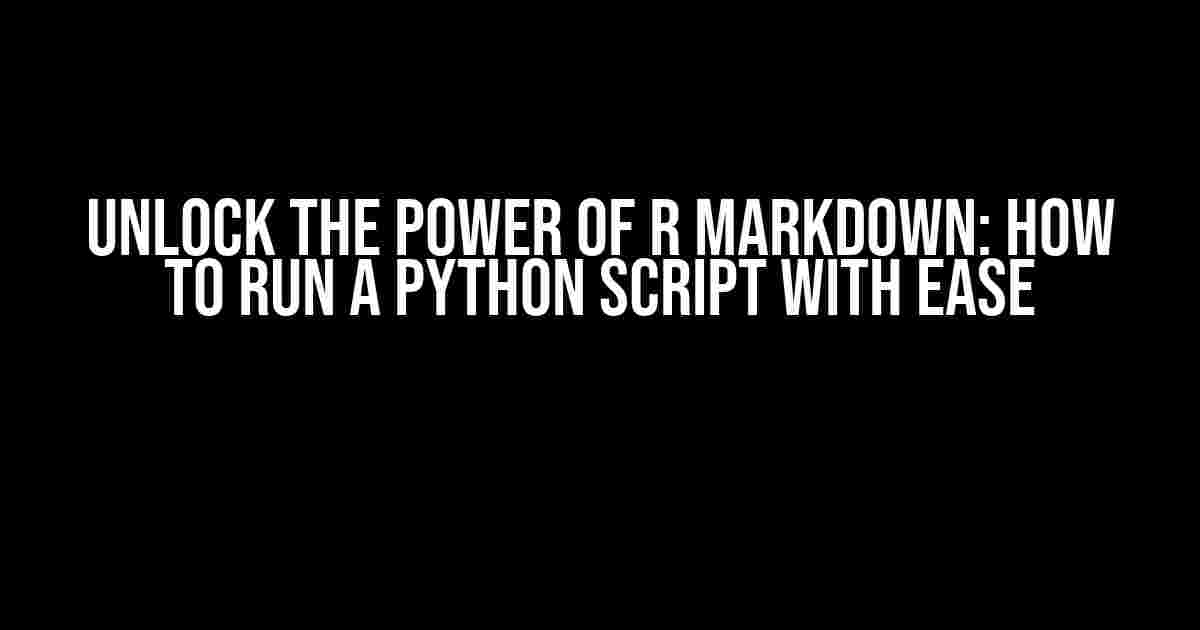Welcome to the world of data analysis and visualization, where R Markdown and Python scripts join forces to create an unstoppable duo. In this comprehensive guide, we’ll delve into the process of running a Python script in R Markdown, covering the why, the how, and the benefits of this powerful combination. So, buckle up and get ready to take your data analysis to the next level!
- What is R Markdown?
- What is a Python Script?
- Why Run a Python Script in R Markdown?
- Prerequisites
- Step 1: Create a Python Script
- Step 2: Install and Load the reticulate Package
- Step 3: Create an R Markdown Document
- Step 4: Run the Python Script in R Markdown
- Step 5: Embed the Python Output
- Step 6: Knit and Render the Document
- Results
- Conclusion
- Additional Resources
What is R Markdown?
R Markdown is a markup language that allows you to create dynamic documents, reports, and presentations from R code. It’s a fantastic tool for data scientists, analysts, and anyone who wants to communicate their findings in a clear, concise, and visually appealing way. R Markdown documents can contain R code, text, images, and even interactive visualizations, making them a versatile and powerful tool for data storytelling.
What is a Python Script?
A Python script is a series of instructions written in the Python programming language. Python is a popular language for data analysis, machine learning, and automation, known for its simplicity, flexibility, and vast libraries. Python scripts can perform a wide range of tasks, from data cleaning and preprocessing to complex modeling and visualization.
Why Run a Python Script in R Markdown?
So, why would you want to run a Python script in R Markdown? Here are just a few compelling reasons:
- Language synergy**: Combine the strengths of R (statistical analysis, visualization) with the strengths of Python (machine learning, automation, web development).
- Workflow efficiency**: Run Python scripts directly within your R Markdown document, eliminating the need for separate environments or workflows.
- Seamless integration**: Embed Python outputs (e.g., plots, tables, results) directly into your R Markdown document, creating a cohesive and polished report.
Prerequisites
Before we dive into the tutorial, make sure you have the following installed:
- R and RStudio (latest versions)
- Python (latest version)
- The
reticulatepackage in R (install withinstall.packages("reticulate")) - A Python script (we’ll create one together)
Step 1: Create a Python Script
Let’s create a simple Python script to demonstrate the process. Open a new Python file (e.g., script.py) and add the following code:
import pandas as pd
# Load a sample dataset
data = pd.read_csv("https://raw.githubusercontent.com/mwaskom/seaborn-data/master/tips.csv")
# Calculate the mean total bill
mean_bill = data["total_bill"].mean()
print("The mean total bill is:", mean_bill)
This script loads the tips dataset, calculates the mean total bill, and prints the result.
Step 2: Install and Load the reticulate Package
In R, install and load the reticulate package, which enables Python integration:
R
install.packages("reticulate")
library(reticulate)
Step 3: Create an R Markdown Document
Create a new R Markdown document (e.g., document.Rmd) and add the following YAML header:
---
title: "Running a Python Script in R Markdown"
output: html_document
---
This sets the document title and specifies the output format as an HTML document.
Step 4: Run the Python Script in R Markdown
In your R Markdown document, add a new code chunk with the following code:
{r, engine = "python", python_script = "script.py"}
This code chunk tells R Markdown to run the script.py Python script using the reticulate engine. You can customize the code chunk to suit your needs, such as specifying input and output files or environment variables.
Step 5: Embed the Python Output
To embed the Python output in your R Markdown document, add a new code chunk with the following code:
{r}
output <- engine$output
paste("The mean total bill is:", output$mean_bill)
This code chunk retrieves the Python output and formats it as a string, which will be displayed in your final document.
Step 6: Knit and Render the Document
Knit your R Markdown document by clicking the "Knit" button in RStudio or by running the following code:
rmarkdown::render("document.Rmd")
This will render the document in HTML format, including the Python script output.
Results
After running the Python script and rendering the document, you should see the following output:
| The mean total bill is: | 19.71 |
Voilà! You've successfully run a Python script in R Markdown, combining the strengths of both languages to create a powerful and flexible data analysis workflow.
Conclusion
In this comprehensive guide, we've demonstrated how to run a Python script in R Markdown, showcasing the benefits of combining these two powerful languages. By following these steps, you can integrate Python scripts into your R Markdown workflow, unlocking new possibilities for data analysis, visualization, and automation. Happy coding!
Remember to experiment with different Python scripts, R Markdown templates, and output formats to unlock the full potential of this powerful combination. The possibilities are endless!
Additional Resources
For more information on R Markdown, Python, and reticulate, check out these resources:
Happy learning and coding!
Frequently Asked Question
Get ready to unleash the power of Python scripts in R Markdown with these frequently asked questions!
What is the purpose of using Python scripts in R Markdown?
Using Python scripts in R Markdown allows you to leverage the strengths of both languages, combining the data analysis and visualization capabilities of R with the machine learning and automation powers of Python. This integration enables you to create more comprehensive and dynamic reports, dashboards, and data science projects.
How do I embed Python code in R Markdown?
To embed Python code in R Markdown, you can use the `python` engine in the R Markdown chunk, like this: ```{python}. This allows you to write Python code directly in your R Markdown document, which will be executed and the output will be displayed inline.
Can I use Python libraries in R Markdown?
Yes, you can use Python libraries in R Markdown by installing them in your Python environment and then loading them in your Python chunks using the `import` statement. For example, you can use popular libraries like pandas, NumPy, and scikit-learn to perform data manipulation, analysis, and modeling tasks.
How do I pass data between R and Python in R Markdown?
You can pass data between R and Python in R Markdown using the `py` object, which provides an interface to the Python interpreter. You can use `py` to execute Python code and retrieve the results, or to pass R objects to Python for further processing.
Is it possible to schedule Python scripts in R Markdown to run automatically?
Yes, you can schedule Python scripts in R Markdown to run automatically using tools like `rmarkdown::render()` and `Sys.sleep()`. You can also use external scheduling tools like `cron` or `scheduleR` to automate the execution of your Python scripts and R Markdown reports.


